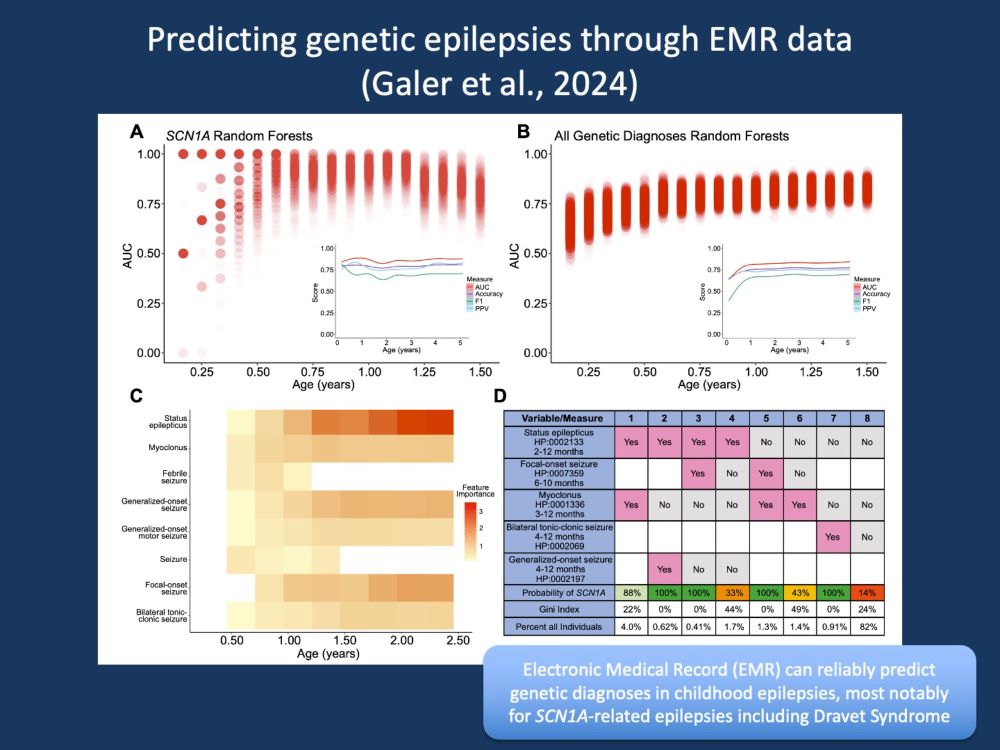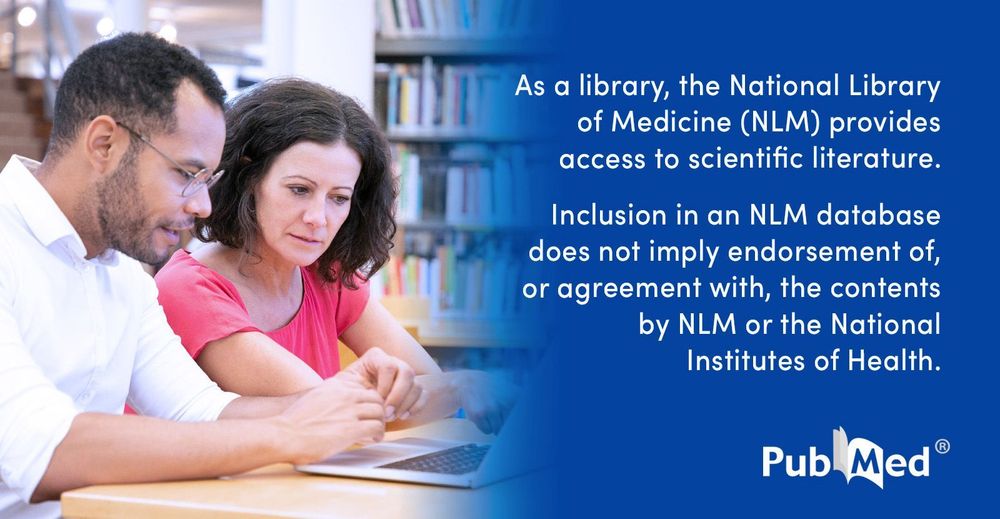
Figure 1. Visualizing the new ACMG/AMP points-based classification system. The diagram shows how different combinations of evidence criteria contribute to variant interpretation under the updated framework. Each bar represents a typical evidence scenario, broken down by individual ACMG/AMP rules such as PVS1 (very strong), PS2–PS4 (strong), PM1–PM6 (moderate), and PP1–PP5 (supporting). Conflicting evidence is indicated by hatched bars, highlighting situations where pathogenic and benign signals pull in opposite directions. Colored background zones indicate the thresholds that define final classifications: Pathogenic (≥10 points), Likely Pathogenic (6–9 points), VUS (0–5 points), Likely Benign (−1 to −6 points), and Benign (≤−7 points, or BA1 as a stand-alone benign criterion). This new quantitative framework turns what once felt like a “word salad” of rules into a transparent and teachable scoring system, marking a quiet revolution in how we approach clinical variant interpretation.
The quiet revolution – revising ACMG criteria for epilepsy genes | Beyond the Ion Channel
...we just published our blog post on the revision of ACMG criteria for epilepsy-related sodium channels
epilepsygenetics.blog/2025/09/04/t...
04.09.2025 21:39 — 👍 3 🔁 0 💬 0 📌 0

Figure 1. The Ice Neurons of Delaware County. When I moved to the United States in 2014, I first encountered a phenomenon on frozen ponds that I had never seen in Europe: neuron-like dendritic patterns etched into lake ice after snowfall. These “ice neurons” arise when wet, heavy snow falls on thin ice, followed by rapid thaw and refreeze. Meltwater seeps through cracks and imperfections, radiating outward in branching channels reminiscent of axons and dendrites. In Delaware County, with its many shallow ponds and frequent freeze–thaw cycles, these conditions align perfectly—creating striking natural structures at the intersection of weather and biology.
The gentle singularity that cannot draw a synapse | Beyond the Ion Channel
..we just published our blog post on the struggle of generative AI to draw a synapse.
epilepsygenetics.blog/2025/08/30/t...
30.08.2025 18:21 — 👍 0 🔁 0 💬 0 📌 0

Figure 1. Function of RANBP2 and neuroimaging in ANE. Figure. Structural model of RanBP2/Nup358 and neuroimaging in acute necrotizing encephalopathy. RanBP2/Nup358 is a major component of the cytoplasmic filaments of the nuclear pore complex, which has an eightfold symmetry with each symmetrical unit referred to as a ‘spoke’. Five copies of RanBP2/Nup358 are found at each spoke, for a total of 40 copies per pore. The N-terminal domain attaches to the pore and is the spot where ANE1 mutations cluster. On the right, magnetic resonance imaging from a 3-year-old child presenting with a viral prodrome and rapid neurological decline. T2-weighted axial images demonstrate the characteristic bilateral thalamic lesions typical of acute necrotizing encephalopathy (figure adapted from Palazzo et al., 2022 under CC BY 4.0, http://creativecommons.org/licenses/by/4.0/).
Influenza and acute necrotizing encephalopathy – the genetic dimension | Beyond the Ion Channel
...we just published our blog post on Acute necrotizing encephalopathy (ANE).
epilepsygenetics.blog/2025/08/28/i...
28.08.2025 18:27 — 👍 0 🔁 0 💬 0 📌 0
![Figure 1. Gene ontology enrichment and overlapping genes in a cross-species analysis for immature granule cell (imGCs). On the left, the top biological pathways are shown for imGC-enriched genes across humans, macaques, pigs, and mice. These pathways, grouped and color-coded by Gene Ontology (GO) terms, highlighting the processes most important for immature neurons, such as neuronal development, synaptic plasticity, and ion transport. This view emphasizes that, while the precise genes differ from species to species, the biological themes remain consistent. On the right, a Venn diagram illustrates how few imGC-enriched genes are shared between species. Only a small set of genes is common to all four, with an additional subset found only in humans and macaques. The lists of shared genes in the boxes serve as concrete examples of this limited overlap, reinforcing the central message of the study: processes can be conserved even when the genes executing them diverge. [Figure modified from data provided by the authors].](https://cdn.bsky.app/img/feed_thumbnail/plain/did:plc:34wa2a54fkqpvbh65qdoqt4h/bafkreiev4eo5vvrsbb7xginra3bs7okf3riur45ojca4mtbsxn6tcnhhkm@jpeg)
Figure 1. Gene ontology enrichment and overlapping genes in a cross-species analysis for immature granule cell (imGCs). On the left, the top biological pathways are shown for imGC-enriched genes across humans, macaques, pigs, and mice. These pathways, grouped and color-coded by Gene Ontology (GO) terms, highlighting the processes most important for immature neurons, such as neuronal development, synaptic plasticity, and ion transport. This view emphasizes that, while the precise genes differ from species to species, the biological themes remain consistent. On the right, a Venn diagram illustrates how few imGC-enriched genes are shared between species. Only a small set of genes is common to all four, with an additional subset found only in humans and macaques. The lists of shared genes in the boxes serve as concrete examples of this limited overlap, reinforcing the central message of the study: processes can be conserved even when the genes executing them diverge. [Figure modified from data provided by the authors].
Different genes, convergent processes – rare disease lessons from neurogenesis | Beyond the Ion Channel
...we just published our blog post on the recent publication by Zhou et al. in Nature Neuroscience
epilepsygenetics.blog/2025/08/26/d...
26.08.2025 18:04 — 👍 1 🔁 0 💬 0 📌 0
Different genes, convergent processes – rare disease lessons from neurogenesis
A paradox in the hippocampus. Immature dentate granule cells are often described as the “plasticity reserve” of the hippocampus. They provide a pool of neurons that integrate into existing circuits, supporting learning, memory, and repair. In neurological disease, these cells have been suggested to buffer against injury or degeneration. In a recent publication, researchers showed that the hippocampus continues to generate new neurons throughout life, but that the molecular instructions for doing so vary dramatically across species.
Different genes, convergent processes – rare disease lessons from neurogenesis
A paradox in the hippocampus. Immature dentate granule cells are often described as the “plasticity reserve” of the hippocampus. They provide a pool of neurons that integrate into existing circuits, supporting learning,…
26.08.2025 17:00 — 👍 0 🔁 0 💬 0 📌 0

Figure 1. Placental weight and fetal growth stratification with corresponding methylation pathways. The nine-block classification system (left) combines placental weight (x-axis, low to high) and fetal-to-placental weight ratio (y-axis, high to low) to categorize neonatal growth patterns. In our cohort, analyses focused on three groups: light placenta with heavy infant (Group A), light placenta with balanced infant growth (Group D), and balanced placenta and infant (Group E, highlighted in red). DNA methylation differences across these groups revealed pathway-specific alterations (right), with gene-set enrichment analyses pointing to biological processes relevant for neurodevelopmental vulnerability in congenital heart disease.
The placental mirror – methylation and neurodevelopment in congenital heart disease – Beyond the Ion Channel
...we just published our blog post on our recent publication on neuronal signatures in umbilical cord blood methylation patterns.
epilepsygenetics.blog/2025/08/24/t...
24.08.2025 19:13 — 👍 0 🔁 0 💬 0 📌 0

Figure 1. Dunes at Rehoboth Beach, Delaware. A stretch near the beach, looking at the beach from the boardwalk facing away from the crowds. Much like rare disease research, some of the most valuable insights happen off the expected path when looking in a different direction. This can often happens in spaces that are less visible.
Three things the beach told me about science in 2025 | Beyond the Ion Channel
...we just published our annual blog post about insights into rare disease research at the beach
epilepsygenetics.blog/2025/08/16/t...
16.08.2025 22:03 — 👍 0 🔁 0 💬 0 📌 0

Figure 1. Miami plot of genome-wide association studies (GWAS) for stuttering in females (top) and males (bottom) of European ancestry. The female GWAS analyzed 570,071 individuals (40,137 cases), identifying nine genome-wide significant loci. The male GWAS included 374,279 individuals (38,257 cases), identifying ten such loci. The x-axis shows genomic coordinates (hg19), the y-axis the −log10(P) values from logistic regression. Dashed lines mark the significance threshold (P < 5 × 10⁻⁸). Genes shown are predicted functional candidates for each locus from the Open Targets Genetics V2G pipeline. This side-by-side view highlights both shared and sex-specific genetic architecture in stuttering (modified from Polikowsky et al, 2025 under a modified from Polikowsky et al., 2025 under a Creative Commons Attribution 4.0 International License http://creativecommons.org/licenses/by/4.0/)
Chasing the Demosthenes gene – the complex genetics of stuttering | Beyond the Ion Channel
...we just published our blog post on a recent large-scale genetic study on stuttering.
epilepsygenetics.blog/2025/08/13/c...
13.08.2025 18:19 — 👍 1 🔁 0 💬 0 📌 0

Figure 1. The core circadian oscillator in human cells is driven by a transcription–translation feedback loop. BMAL1 (ARNTL) dimerizes with CLOCK to form a transcriptional activator complex that binds to E-box elements in the promoters of PER and CRY genes. The translated PER and CRY proteins accumulate in the cytoplasm, heterodimerize, and translocate back into the nucleus, where they inhibit the activity of BMAL1 and CLOCK, repressing their own transcription. This cycle takes approximately 24 hours to complete and represents the molecular pacemaker that governs circadian rhythms such as sleep-wake cycles, hormonal secretion, and metabolic regulation. In our study by Cuddapah and collaborators, we identified ten individuals with de novo or rare heterozygous variants in ARNTL. All individuals presented with neurodevelopmental features, including intellectual disability, hypotonia, and epilepsy. (Figure created with Biorender).
Beyond Sleep: BMAL1 links circadian time to neurodevelopment and epilepsy | Beyond the Ion Channel
...here is our blog post on BMAL1 (ARNTL), a core component of the circadian clock, and neurodevelopmental disorders.
epilepsygenetics.blog/2025/08/10/b...
11.08.2025 16:08 — 👍 1 🔁 0 💬 0 📌 0

Figure 1. The Kamp Abbey in Kamp-Lintfort, Germany, viewed from the entrance. Founded in 1123, this Cistercian monastery has played a pivotal role in shaping the intellectual and spiritual landscape of the region, including contributions to monastic scholarship and agricultural innovations.
Tenure into the Unknown | Beyond the Ion Channel
...in July 2025, I was granted tenure at the University of Pennsylvania.
...here is my blog post about the historic Cistercian abbey in my hometown, academic reforms in the 19th century, and what to do with tenure in 2025.
08.08.2025 13:10 — 👍 0 🔁 0 💬 0 📌 0
The power of paralogs in epilepsy genetics | Beyond the Ion Channel
...we just published our post on our recent publication on the importance of identical variants at conserved sites in epilepsy genes.
epilepsygenetics.blog/2025/07/29/t...
29.07.2025 13:16 — 👍 0 🔁 0 💬 0 📌 0
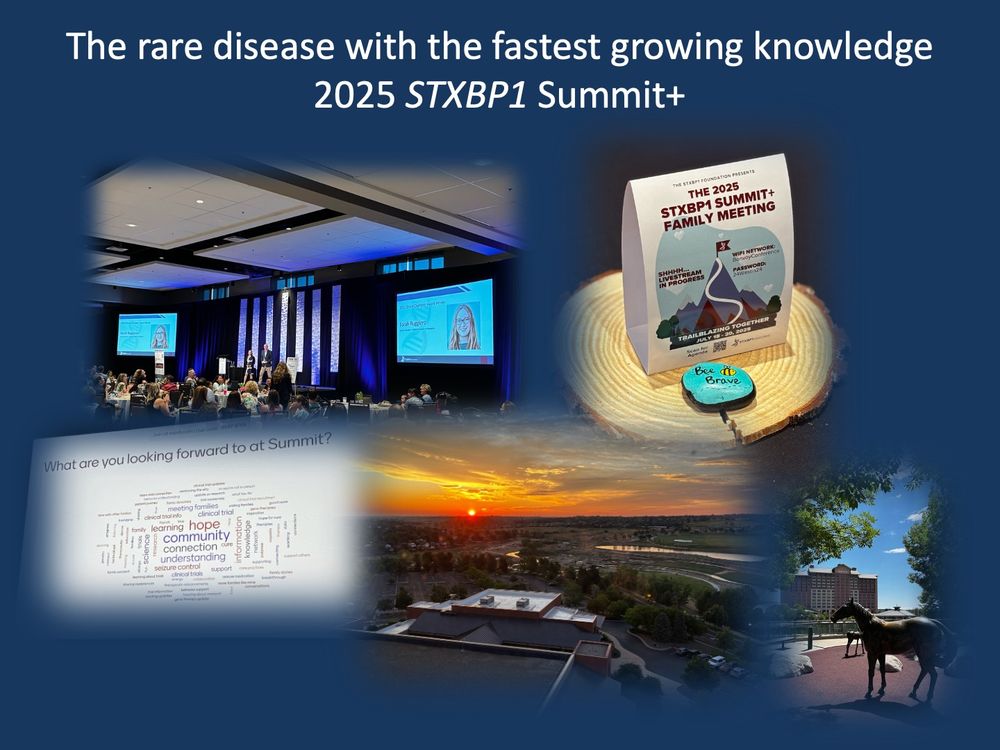
Figure 1. Impressions from the 2025 STXBP1 Summit+, including Sarah’s award as the 2025 Clinical Champion, our “Bee Brave” painted stone at our conference table, the interactive word cloud at the start of the meeting, the epic Colorado sunrise, and a view of the Westin in Westminster, Colorado that hosted the STXBP1 family meeting for the second time in 2025. More impressions of the 2025 STXBP1 Summit+ can be found at https://www.stxbp1disorders.org/2025-summit.
The rare disease with fastest growing knowledge – the 2025 STXBP1 Summit+ | Beyond the Ion Channel
...we just published our blog post on the 2025 STXBP1 Family Summit+ in Westminster, Colorado
epilepsygenetics.blog/2025/07/26/t...
26.07.2025 15:29 — 👍 0 🔁 0 💬 0 📌 0
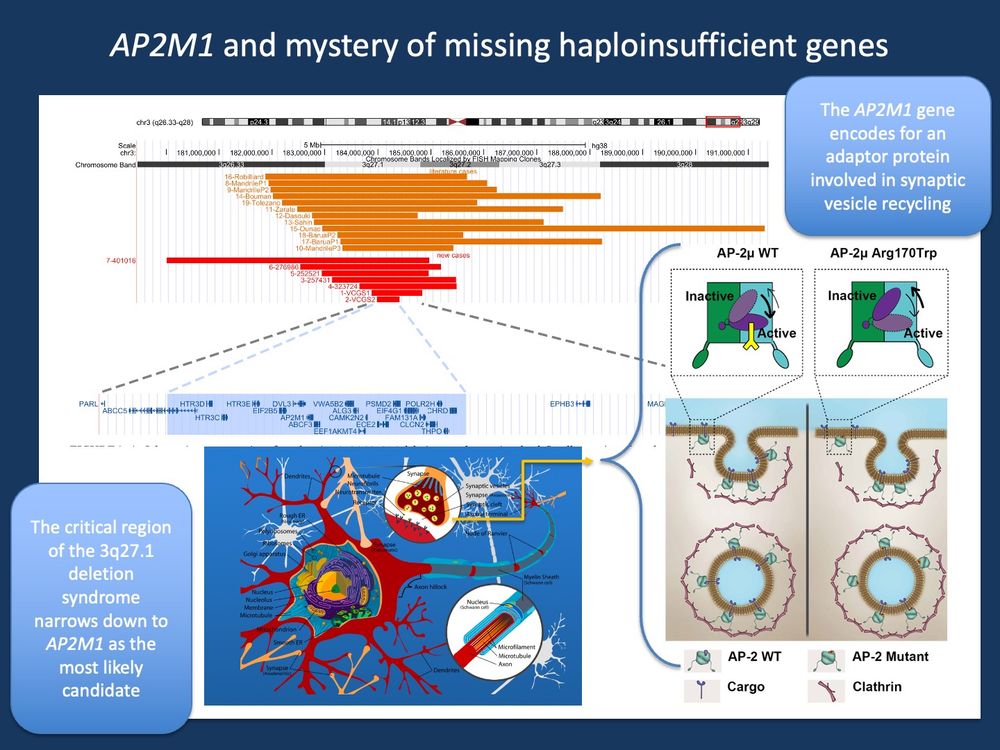
Figure 1. Schematic representation of overlapping 3q26.3-3q27.2 deletions, and genes involved. The smallest region of overlap (light blue) is 0.43 Mb, encompassing 20 protein-coding genes including AP2M1. The AP2M1 gene encodes a presynaptic adapter protein involved in initiating the first step of synaptic vesicle recycling. The recurrent AP2M1 p.Arg170Trp variant had previously been identified to impair synaptic vesicle recycling and cause genetic epilepsies with clinical features of myoclonic astatic epilepsies (MAE). However, prior to the publication by Gear et al., 2025, haploinsufficiency in AP2M1 had not been known as a disease mechanism (adapted from Gear et al., 2025 under a under the terms of the Creative Commons Attribution and Supplemental data by Helbig et al., 2019).
AP2M1 and the mystery of missing haploinsufficient genes | Beyond the Ion Channel
...we just published our blog post on AP2M1 as the candidate gene in the 3q27 microdeletion
...and the broader issue of missing haploinsufficient genes
epilepsygenetics.blog/2025/07/21/a...
22.07.2025 10:41 — 👍 0 🔁 0 💬 0 📌 0
RT @NeuroWoodworks: An astrocyte sculpture made out of cherry wood. Neurons are not the only important cells of the brain!!!
14.07.2025 13:56 — 👍 0 🔁 0 💬 0 📌 0

Figure 1. Burden analysis of rare variants in 34,000 individuals of the 100,000 Genomes Project before applying additional prioritization filters. Well-established epilepsy genes including SCN1A, KCNQ2, and DEPDC5 show strong associations, including associations through different analysis methods (duplicate dots for SCN1A). This QQ plot was generated from the Open Access Supplemental Data by Cipriani and collaborators. The insert compares data from the 100K Genomes Project to raw Epi25 data from the Epi25 browser.
Beyond the Ion Channel | RBFOX3 and the Hunt for Epilepsy Genes in 100,000 Genomes
...we just published our post of the discovery of RBFOX3 as a candidate gene from the 100,000 Genomes Project
11.07.2025 12:15 — 👍 1 🔁 0 💬 0 📌 0
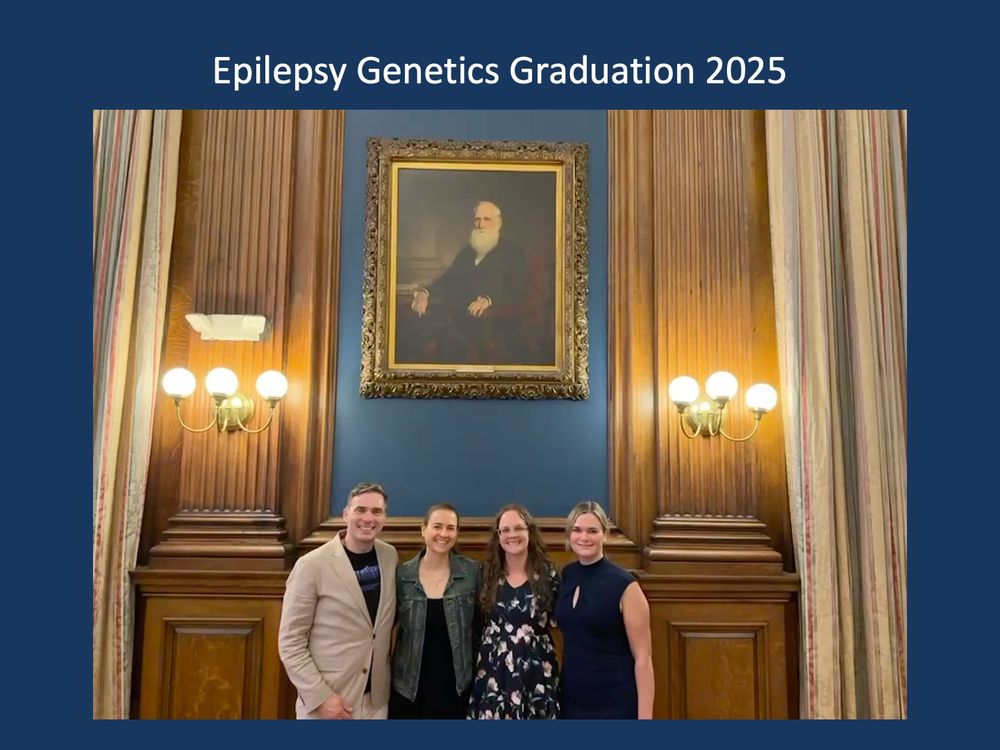
Epilepsy Genetics Graduation 2025. Our ENGIN fellowship team 2025 including (left to right from myself) our incoming fellow Riley Kessler, graduating fellow Laura McGarry, and current fellowship director Jill McKee. The CHOP Neurology graduation typically takes place in the Philadelphia College of Physicians aka the “hall of old white men with beards”. This is us under the portrait of Alfred Stillé (1813–1900) who advanced American medicine through education reforms and who help shape modern medical professionalism by being a critical part in founding the American Medical Association.
Five principles for teaching epilepsy genetics | Beyond the Ion Channel
...our blog post celebrating the 5th anniversary of our ENGIN epilepsy genetics fellowship
epilepsygenetics.blog/2025/07/08/f...
08.07.2025 16:34 — 👍 1 🔁 1 💬 0 📌 0
RT @NTFabiano: This is the Atlas of Cognitive Disorders
08.07.2025 13:48 — 👍 0 🔁 0 💬 0 📌 0
RT @DiseaseGenes: The Spectrum of Neurologic Phenotypes Associated With NUS1 Pathogenic Variants: A Comprehensive Case Series
07.07.2025 13:56 — 👍 0 🔁 0 💬 0 📌 0
RT @tangming2005: Writing online has taught me more than I ever expected. Here’s why I do it and what I’ve learned along the way.
24.06.2025 13:48 — 👍 0 🔁 0 💬 0 📌 0
Professor at the NYU School of Medicine (https://yanailab.org/). Co-founder and Director of the Night Science Institute (https://night-science.org/). Co-host of the 'Night Science Podcast' https://podcasts.apple.com/us/podcast/night-science/id1563415749
Create and share social media content anywhere, consistently.
Built with 💙 by a global, remote team.
⬇️ Learn more about Buffer & Bluesky
https://buffer.com/bluesky
Professor of Genetics, Perelman School of Medicine, University of Pennsylvania
hearing loss, brain development, gene regulation
Assistant Professor of Genetics and Core Member of the Epigenetics Institute at UPenn | T2T, HPRC, and HGSVC member | Loves genomics, epigenomics, and synthetic biology | logsdonlab.com
Physician Scientist | Nephrology | Translational Research | Single-Cell & Spatial Omics | Precision Medicine | Kidney Innovation | Advocate for Patient-Centered Science | Views My Own
Associate Professor, University of Pennsylvania, Penn Epigenetics Institute
3D Genome structure and function
https://ericjoycelab.com/
Neurogeneticist/ Sleep and Psychiatric genetics 🧬 UPenn+CHOP / Pretty good runner
Laboratory for Chromatin and Spatial Neurobiology
We work at the intersection of chromatin, synapses, and neurobiology to understand how the brain stores memory over long timescales.
creminslab.com
x.com/creminslab
https://videocast.nih.gov/watch=55006
Professor, Geneticist, Human Evolutionary Biologist, Wife, Mom
Posts reflect my own personal views and not any of the organizations I am affiliated with.
Associate Professor of Genetics, University of Pennsylvania
Single-cell biology, cancer genomics, mathematical methods. Biology, physics, and music lover
This is the official account for Penn Genetics – the Perelman School of Medicine at University of Pennsylvania.
https://genetics.med.upenn.edu
Penn Epigenetics Institute at The University of Pennsylvania Perelman School of Medicine, Philadelphia, PA
Brain scientist who studies how we hear and form memories of sounds 🧠 🧬🔬🧪; prof at Penn. Loves🧘♀️🚴♀️✈️🥐🧶📷⛷️🏔️. Mom to 👦👧👦🐈🐈. Lab: hosting.med.UPenn.edu/hearing
Department of Genetics, Institute for Immunology and Immune Health, Epigenetics Institute, University of Pennsylvania
https://vahedilab.com/ https://www.instagram.com/vahedilaboratory/
Opinions - own. Lab RNA+AI+Genetics @upenn.edu
www.biociphers.org
Professor of Genetics, UPenn. Diabetes and organ development. Member of the Human Pancreas Analysis Program.
Interested in epigenetics, cancer biology, and learning!



![Figure 1. Gene ontology enrichment and overlapping genes in a cross-species analysis for immature granule cell (imGCs). On the left, the top biological pathways are shown for imGC-enriched genes across humans, macaques, pigs, and mice. These pathways, grouped and color-coded by Gene Ontology (GO) terms, highlighting the processes most important for immature neurons, such as neuronal development, synaptic plasticity, and ion transport. This view emphasizes that, while the precise genes differ from species to species, the biological themes remain consistent. On the right, a Venn diagram illustrates how few imGC-enriched genes are shared between species. Only a small set of genes is common to all four, with an additional subset found only in humans and macaques. The lists of shared genes in the boxes serve as concrete examples of this limited overlap, reinforcing the central message of the study: processes can be conserved even when the genes executing them diverge. [Figure modified from data provided by the authors].](https://cdn.bsky.app/img/feed_thumbnail/plain/did:plc:34wa2a54fkqpvbh65qdoqt4h/bafkreiev4eo5vvrsbb7xginra3bs7okf3riur45ojca4mtbsxn6tcnhhkm@jpeg)









